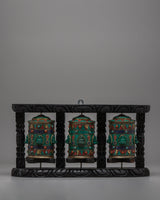
Spinning Buddhist Prayer Wheel | Enhancing Devotion with a Copper Bodied Spiritual Wheel

100% AUTHENTIC

HANDMADE

FREE SHIPPING
Spinning Buddhist Prayer Wheel
About The Prayer Wheel
The Buddhist Prayer Wheel that spins is a complex representation of both artistry and spiritual devotion. Its intricately carved wooden frame serves as a strong support system for the copper wheels that are set with faux stones including coral, lapis lazuli, and turquoise. The wheel is made more visually appealing by this combination of materials, which also gives it symbolic meaning by symbolizing the abundance of both the natural world and Buddhist tradition.
This beautiful innovation, a 3-in-1 prayer wheel, gives practitioners an exceptional chance to interact with many prayers and mantras at once, enhancing the effectiveness of their spiritual practice. Blessings are thought to radiate outward with each turn of the wheel, bringing compassion and optimism to all living things. The Spinning Buddhist Prayer Wheel is a powerful tool for spiritual transformation and a material representation of devotion that can be utilized in private meditation or displayed in hallowed places.
Introduction to Prayer Wheel
A prayer wheel is a cylindrical wheel on a spindle used in Tibetan Buddhism. It is typically inscribed with the mantra "Om Mani Padme Hum" and rotated by hand as a form of spiritual practice and to accumulate merit. Spinning the wheel is believed to have the same spiritual benefits as verbally reciting the mantra. The use of prayer wheels is widespread in Tibetan Buddhism and has spread to other cultures.
--------------------------------------------------------
Size: 19.5 cm(Height) x 35 cm(Width)
Weight: 1.21 kg
Material: Copper Body, Brass, Coral, Turquoise, Lapis Lazuli, Wood
--------------------------------------------------------
How does Buddhist Prayer Wheel benefit us?
The benefits associated with rotating the wheel are numerous. It promotes knowledge, compassion, and bodhicitta in the practitioner and improves siddhis (spiritual powers such as clairvoyance, precognition, etc.). The practitioner can repeat the mantra as often as possible while the wheel is rolling, maintaining a calm, meditative attitude. A Tibetan Buddhist tradition holds that at the completion of a practice session, one should dedicate any acquired merits to the benefit of all sentient beings. Then three times Om Ah Hum. This is usually among Tibetans after finishing any Buddhist practice, including the prayer wheel exercise.
Why choose Evamratna?
To give your space a peaceful, powerful, and attractive feel, we are introducing Buddhism-inspired home décor items to enliven your space with zen vibes, in the form of decoration, an art form, or inspiration.
Shipping & Returns
We ship worldwide. Orders dispatch in 2–3 business days. International delivery typically arrives in 4–10 business days via DHL Express, depending on destination and carrier conditions. All items ship free globally.
Returns are accepted within 14 days of delivery. Products must be returned in original condition for a refund to be issued once received and inspected. Terms and conditions apply.











